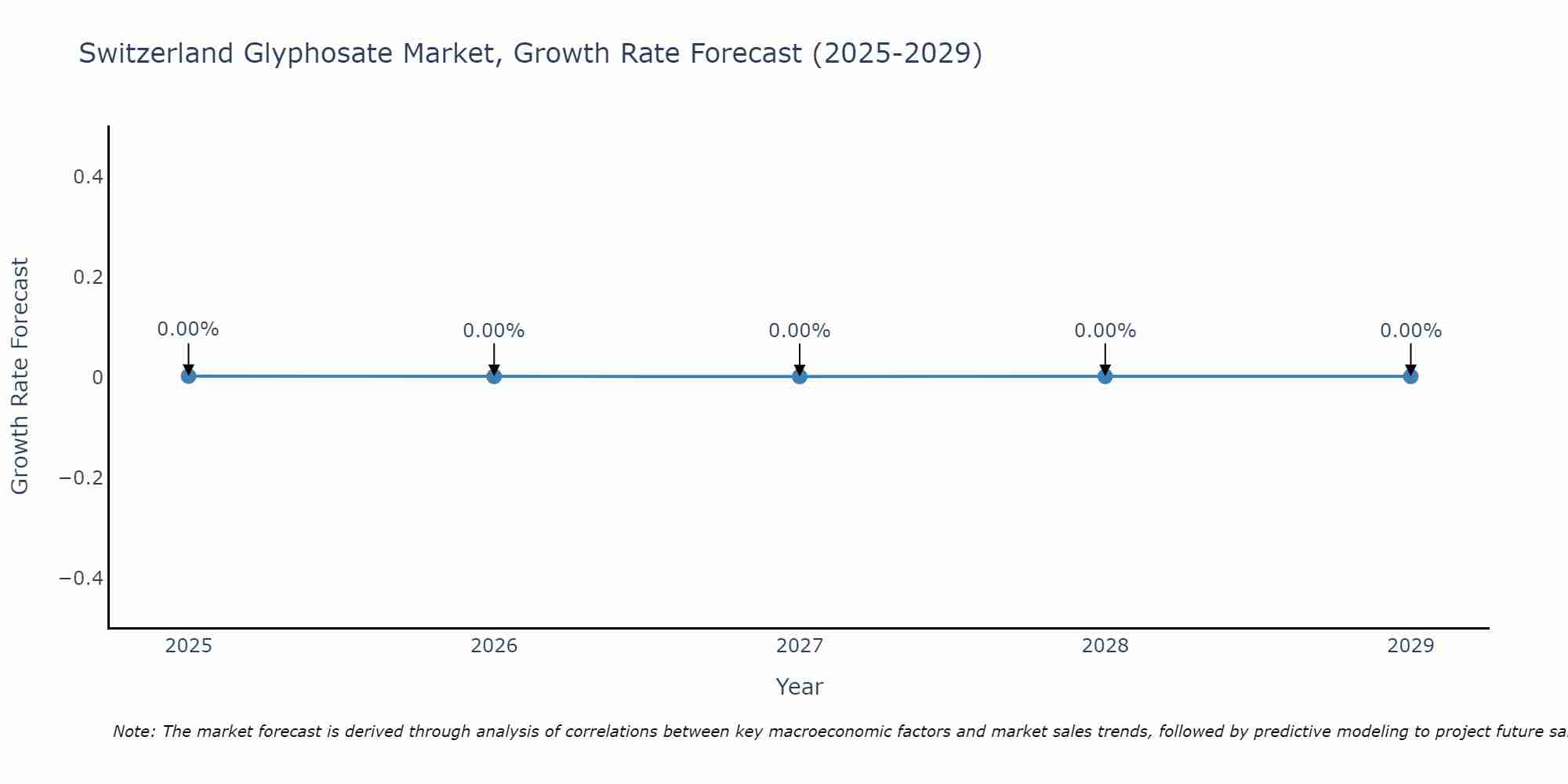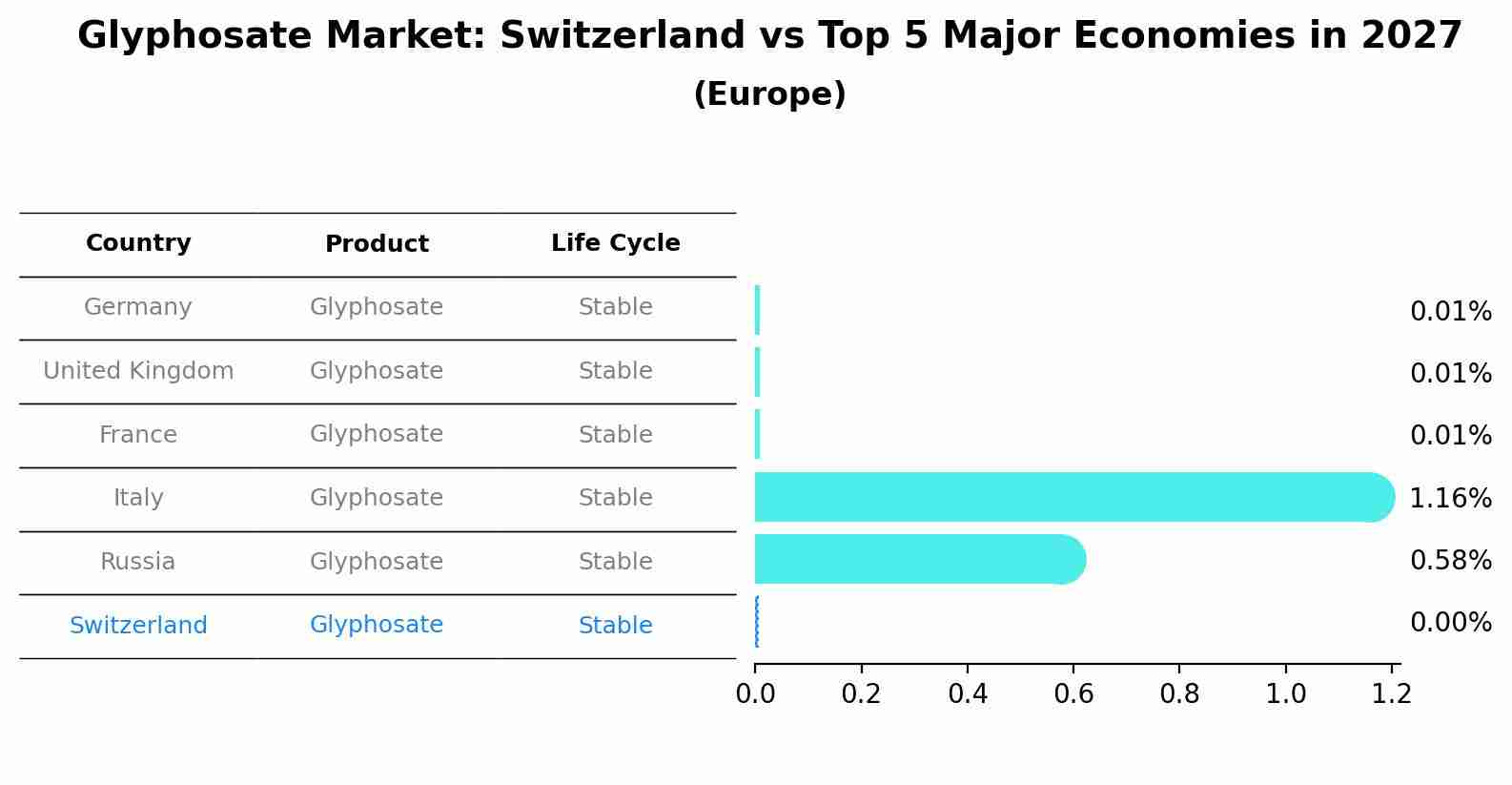Switzerland Glyphosate Market (2025-2031) | Analysis, Value, Trends, Share, Revenue, Industry, Segmentation, Growth, Forecast, Companies, Size & Outlook
| Product Code: ETC5356285 | Publication Date: Nov 2023 | Updated Date: Aug 2025 | Product Type: Market Research Report | |
| Publisher: 6Wresearch | Author: Bhawna Singh | No. of Pages: 60 | No. of Figures: 30 | No. of Tables: 5 |
Switzerland Glyphosate Market Size Growth Rate
The Switzerland Glyphosate Market is projected to witness mixed growth rate patterns during 2025 to 2029. Although the growth rate starts strong at 0.00% in 2025, it steadily loses momentum, ending at 0.00% by 2029.

Glyphosate Market: Switzerland vs Top 5 Major Economies in 2027 (Europe)
The Glyphosate market in Switzerland is projected to grow at a stable growth rate of 0.00% by 2027, within the Europe region led by Germany, along with other countries like United Kingdom, France, Italy and Russia, collectively shaping a dynamic and evolving market environment driven by innovation and increasing adoption of emerging technologies.

Switzerland Glyphosate Market Overview
Glyphosate, a widely used herbicide, has a stable presence in Switzerlands agricultural sector. Despite global debates about its environmental and health impacts, the glyphosate market in Switzerland remains regulated, with strict guidelines ensuring its responsible use. Farmers rely on glyphosate for effective weed control, particularly in grain and oilseed production. However, increasing environmental concerns and the potential for future regulatory changes are pushing the market towards exploring alternative, eco-friendly herbicides.
Drivers of the market
The glyphosate market in Switzerland is influenced by the agricultural sectors need for effective weed management solutions. Glyphosate is widely used as a herbicide in crop production, contributing to higher yields and improved efficiency for farmers. The increasing focus on food security and sustainable agricultural practices is driving the demand for glyphosate, as it allows for reduced tillage and minimal soil disruption. Furthermore, the introduction of genetically modified crops resistant to glyphosate has reinforced its position in the market, making it an essential tool for modern agriculture.
Challenges of the market
The glyphosate market is increasingly facing challenges due to regulatory scrutiny and public concern over health and environmental impacts. As more studies link glyphosate to potential health risks, consumer sentiment is shifting against its use, leading to calls for bans or restrictions. This growing opposition can limit market opportunities for glyphosate producers. Additionally, competition from organic and non-chemical pest control methods is on the rise, forcing glyphosate manufacturers to adapt to a changing agricultural landscape.
Government Policy of the market
The Swiss government has been proactive in regulating glyphosate, especially in light of health and environmental concerns. Recent policies have focused on risk assessment and promoting alternative pest control methods. The Swiss authorities are committed to adhering to EU regulations regarding pesticide use, which include thorough evaluations of glyphosate`s safety and environmental impact.
Key Highlights of the Report:
- Switzerland Glyphosate Market Outlook
- Market Size of Switzerland Glyphosate Market, 2024
- Forecast of Switzerland Glyphosate Market, 2031
- Historical Data and Forecast of Switzerland Glyphosate Revenues & Volume for the Period 2021-2031
- Switzerland Glyphosate Market Trend Evolution
- Switzerland Glyphosate Market Drivers and Challenges
- Switzerland Glyphosate Price Trends
- Switzerland Glyphosate Porter`s Five Forces
- Switzerland Glyphosate Industry Life Cycle
- Historical Data and Forecast of Switzerland Glyphosate Market Revenues & Volume By Application for the Period 2021-2031
- Historical Data and Forecast of Switzerland Glyphosate Market Revenues & Volume By Genetically Modified (GM) Crops for the Period 2021-2031
- Historical Data and Forecast of Switzerland Glyphosate Market Revenues & Volume By Conventional Crops for the Period 2021-2031
- Switzerland Glyphosate Import Export Trade Statistics
- Market Opportunity Assessment By Application
- Switzerland Glyphosate Top Companies Market Share
- Switzerland Glyphosate Competitive Benchmarking By Technical and Operational Parameters
- Switzerland Glyphosate Company Profiles
- Switzerland Glyphosate Key Strategic Recommendations
Frequently Asked Questions About the Market Study (FAQs):
1 Executive Summary |
2 Introduction |
2.1 Key Highlights of the Report |
2.2 Report Description |
2.3 Market Scope & Segmentation |
2.4 Research Methodology |
2.5 Assumptions |
3 Switzerland Glyphosate Market Overview |
3.1 Switzerland Country Macro Economic Indicators |
3.2 Switzerland Glyphosate Market Revenues & Volume, 2021 & 2031F |
3.3 Switzerland Glyphosate Market - Industry Life Cycle |
3.4 Switzerland Glyphosate Market - Porter's Five Forces |
3.5 Switzerland Glyphosate Market Revenues & Volume Share, By Application, 2021 & 2031F |
4 Switzerland Glyphosate Market Dynamics |
4.1 Impact Analysis |
4.2 Market Drivers |
4.2.1 Increasing demand for high crop yields and quality due to growing population and changing dietary habits |
4.2.2 Adoption of genetically modified (GM) crops that require glyphosate-based herbicides for effective weed control |
4.2.3 Rising awareness among farmers about the benefits of using glyphosate in terms of cost-effectiveness and convenience |
4.3 Market Restraints |
4.3.1 Stringent regulations and potential bans on glyphosate due to environmental and health concerns |
4.3.2 Growing preference for organic farming practices leading to reduced usage of chemical herbicides |
4.3.3 Emergence of glyphosate-resistant weeds impacting the efficacy of glyphosate-based products |
5 Switzerland Glyphosate Market Trends |
6 Switzerland Glyphosate Market Segmentations |
6.1 Switzerland Glyphosate Market, By Application |
6.1.1 Overview and Analysis |
6.1.2 Switzerland Glyphosate Market Revenues & Volume, By Genetically Modified (GM) Crops, 2021-2031F |
6.1.3 Switzerland Glyphosate Market Revenues & Volume, By Conventional Crops, 2021-2031F |
7 Switzerland Glyphosate Market Import-Export Trade Statistics |
7.1 Switzerland Glyphosate Market Export to Major Countries |
7.2 Switzerland Glyphosate Market Imports from Major Countries |
8 Switzerland Glyphosate Market Key Performance Indicators |
8.1 Adoption rate of GM crops in Switzerland |
8.2 Number of new product launches and innovations in the glyphosate market |
8.3 Usage of alternative weed control methods in agriculture |
9 Switzerland Glyphosate Market - Opportunity Assessment |
9.1 Switzerland Glyphosate Market Opportunity Assessment, By Application, 2021 & 2031F |
10 Switzerland Glyphosate Market - Competitive Landscape |
10.1 Switzerland Glyphosate Market Revenue Share, By Companies, 2024 |
10.2 Switzerland Glyphosate Market Competitive Benchmarking, By Operating and Technical Parameters |
11 Company Profiles |
12 Recommendations | 13 Disclaimer |
- Single User License$ 1,995
- Department License$ 2,400
- Site License$ 3,120
- Global License$ 3,795
Search
Thought Leadership and Analyst Meet
Our Clients
Related Reports
- Canada Oil and Gas Market (2026-2032) | Share, Segmentation, Value, Industry, Trends, Forecast, Analysis, Size & Revenue, Growth, Competitive Landscape, Outlook, Companies
- Germany Breakfast Food Market (2026-2032) | Industry, Share, Growth, Size, Companies, Value, Analysis, Revenue, Trends, Forecast & Outlook
- Australia Briquette Market (2025-2031) | Growth, Size, Revenue, Forecast, Analysis, Trends, Value, Share, Industry & Companies
- Vietnam System Integrator Market (2025-2031) | Size, Companies, Analysis, Industry, Value, Forecast, Growth, Trends, Revenue & Share
- ASEAN and Thailand Brain Health Supplements Market (2025-2031) | Strategy, Consumer Insights, Analysis, Investment Trends, Opportunities, Growth, Size, Share, Industry, Revenue, Segments, Value, Segmentation, Supply, Forecast, Restraints, Outlook, Competition, Drivers, Trends, Demand, Pricing Analysis, Competitive, Strategic Insights, Companies, Challenges
- ASEAN Bearings Market (2025-2031) | Strategy, Consumer Insights, Analysis, Investment Trends, Opportunities, Growth, Size, Share, Industry, Revenue, Segments, Value, Segmentation, Supply, Forecast, Restraints, Outlook, Competition, Drivers, Trends, Demand, Pricing Analysis, Competitive, Strategic Insights, Companies, Challenges
- Europe Flooring Market (2025-2031) | Outlook, Share, Industry, Trends, Forecast, Companies, Revenue, Size, Analysis, Growth & Value
- Saudi Arabia Manlift Market (2025-2031) | Outlook, Size, Growth, Trends, Companies, Industry, Revenue, Value, Share, Forecast & Analysis
- Uganda Excavator, Crane, and Wheel Loaders Market (2025-2031) | Strategy, Consumer Insights, Analysis, Investment Trends, Opportunities, Growth, Size, Share, Industry, Revenue, Segments, Value, Segmentation, Supply, Forecast, Restraints, Outlook, Competition, Drivers, Trends, Demand, Pricing Analysis, Competitive, Strategic Insights, Companies, Challenges
- Rwanda Excavator, Crane, and Wheel Loaders Market (2025-2031) | Strategy, Consumer Insights, Analysis, Investment Trends, Opportunities, Growth, Size, Share, Industry, Revenue, Segments, Value, Segmentation, Supply, Forecast, Restraints, Outlook, Competition, Drivers, Trends, Demand, Pricing Analysis, Competitive, Strategic Insights, Companies, Challenges
Industry Events and Analyst Meet
Whitepaper
- Middle East & Africa Commercial Security Market Click here to view more.
- Middle East & Africa Fire Safety Systems & Equipment Market Click here to view more.
- GCC Drone Market Click here to view more.
- Middle East Lighting Fixture Market Click here to view more.
- GCC Physical & Perimeter Security Market Click here to view more.
6WResearch In News
- Doha a strategic location for EV manufacturing hub: IPA Qatar
- Demand for luxury TVs surging in the GCC, says Samsung
- Empowering Growth: The Thriving Journey of Bangladesh’s Cable Industry
- Demand for luxury TVs surging in the GCC, says Samsung
- Video call with a traditional healer? Once unthinkable, it’s now common in South Africa
- Intelligent Buildings To Smooth GCC’s Path To Net Zero


















